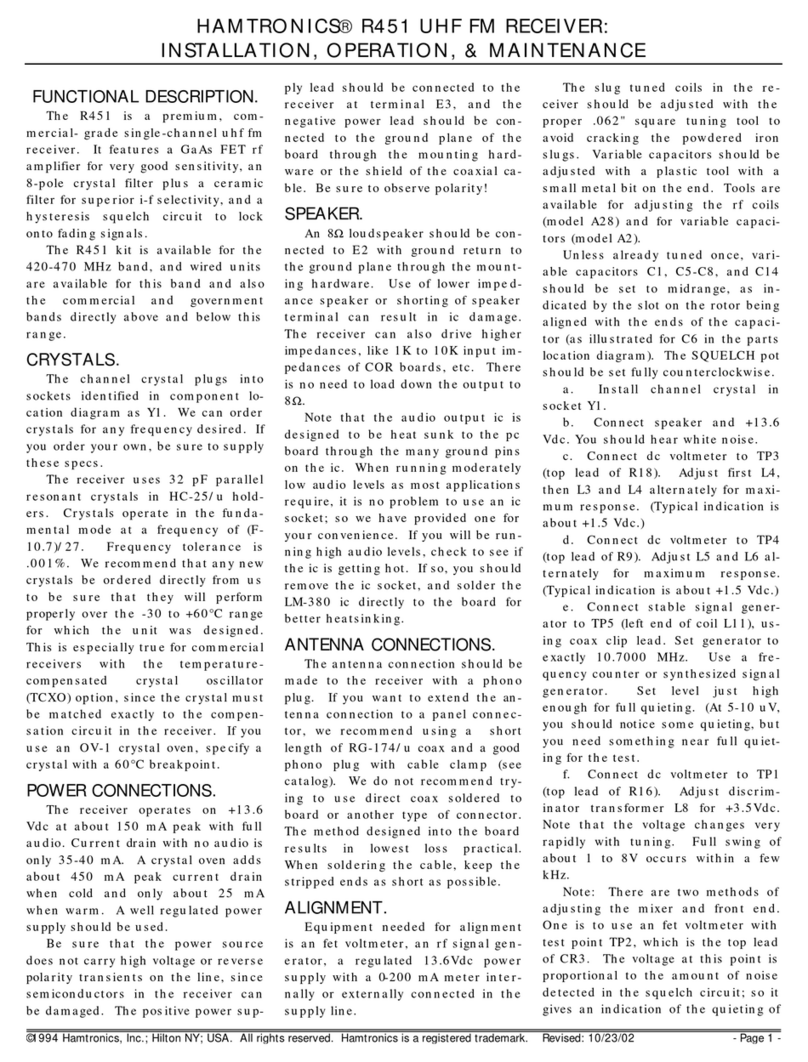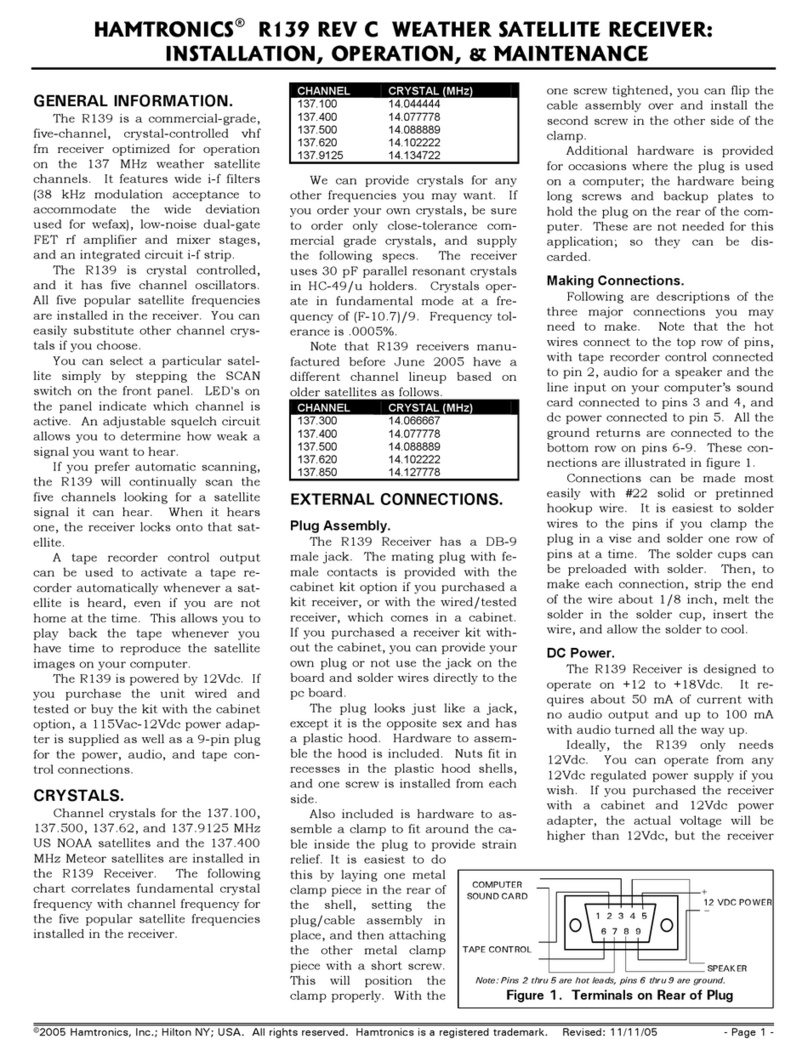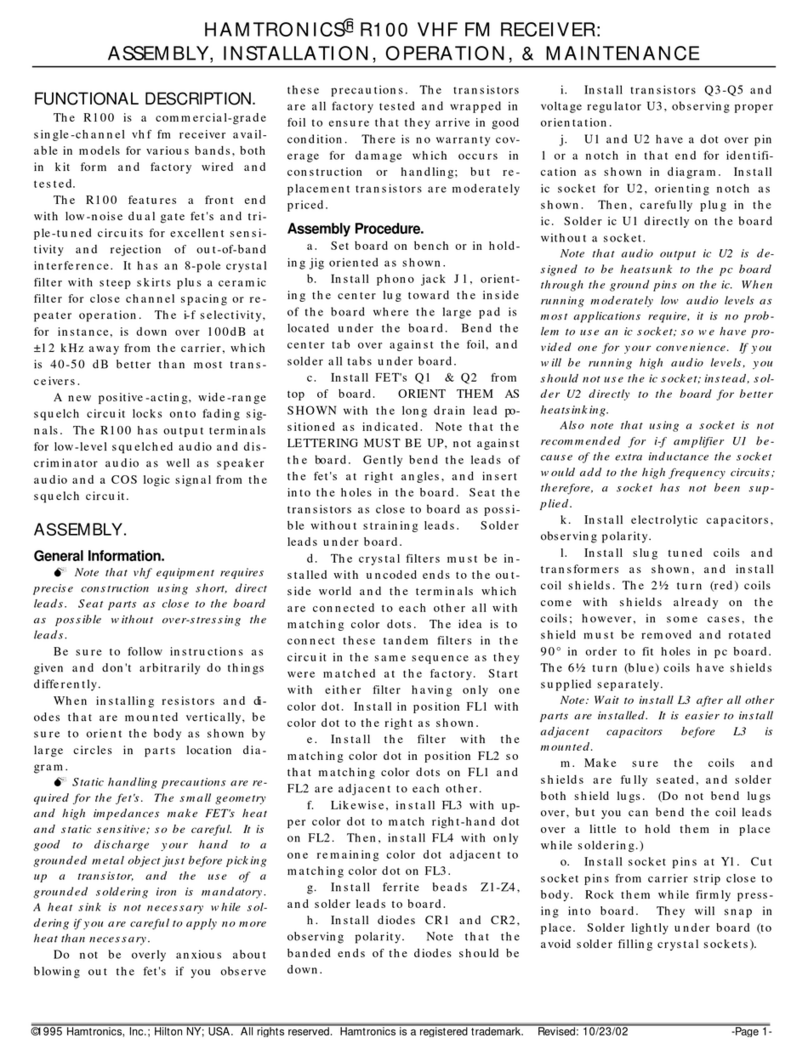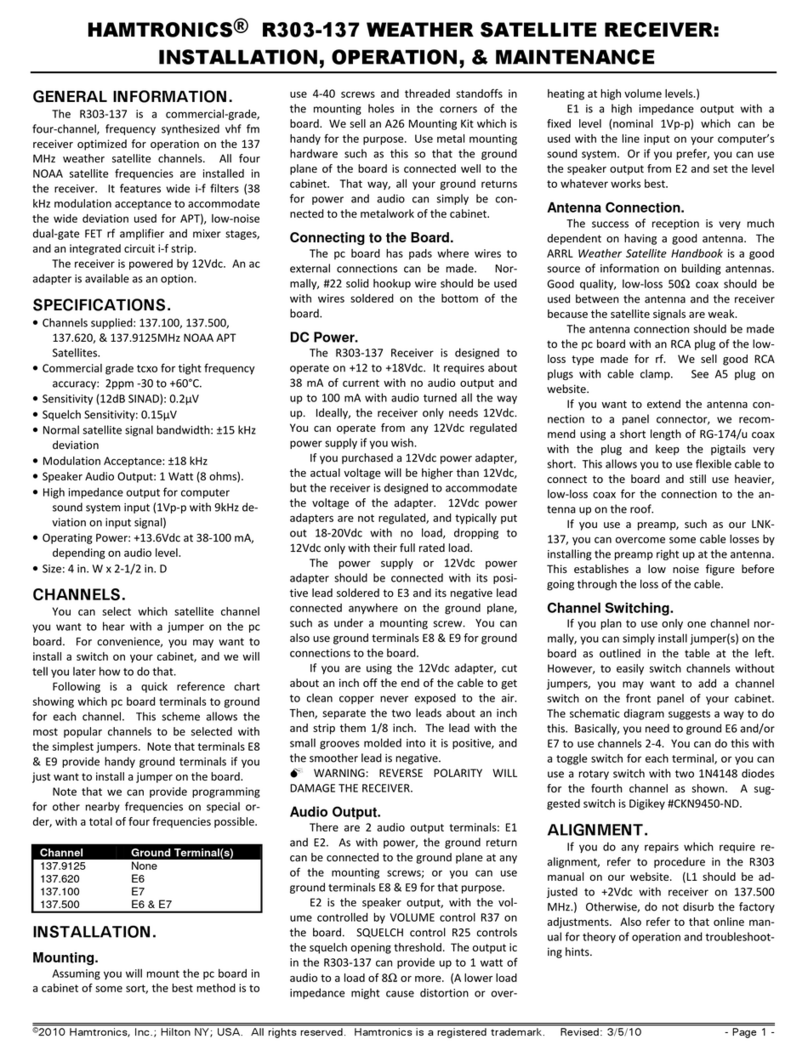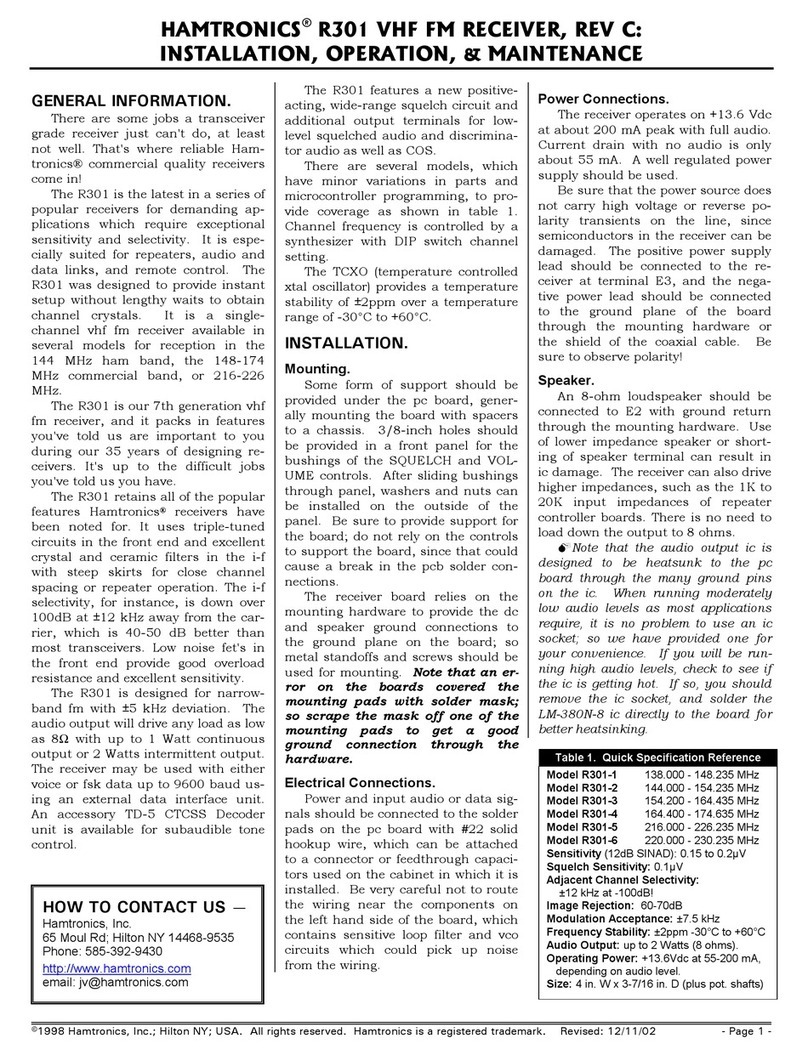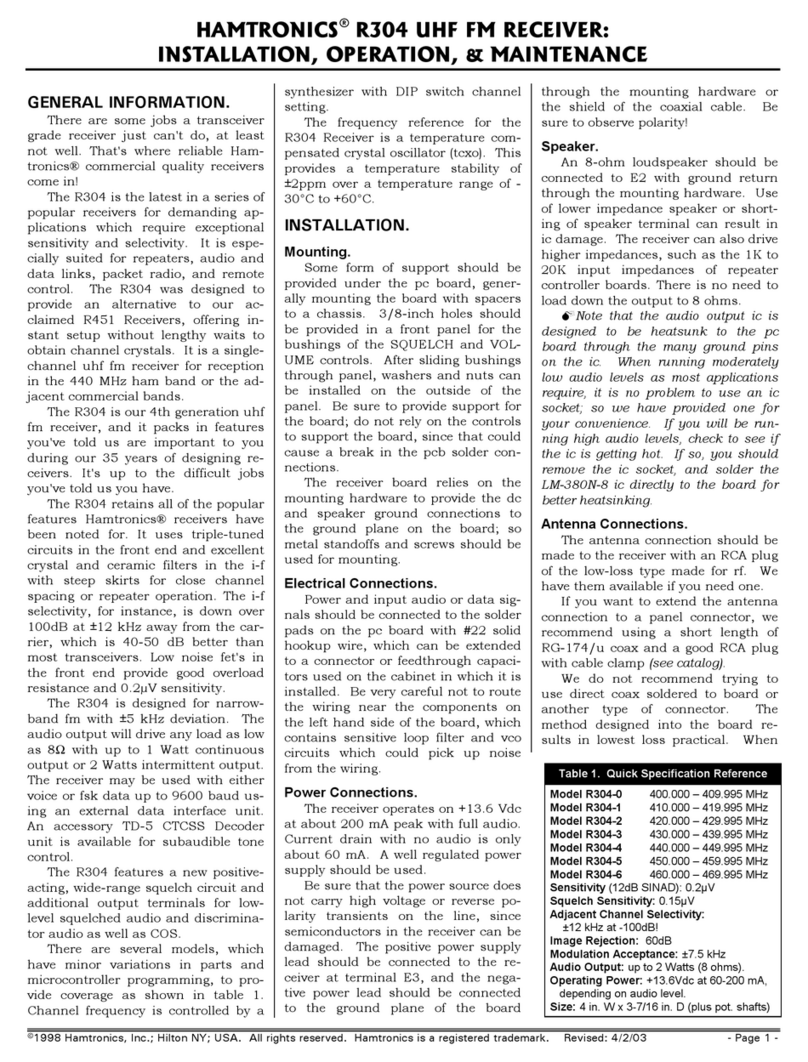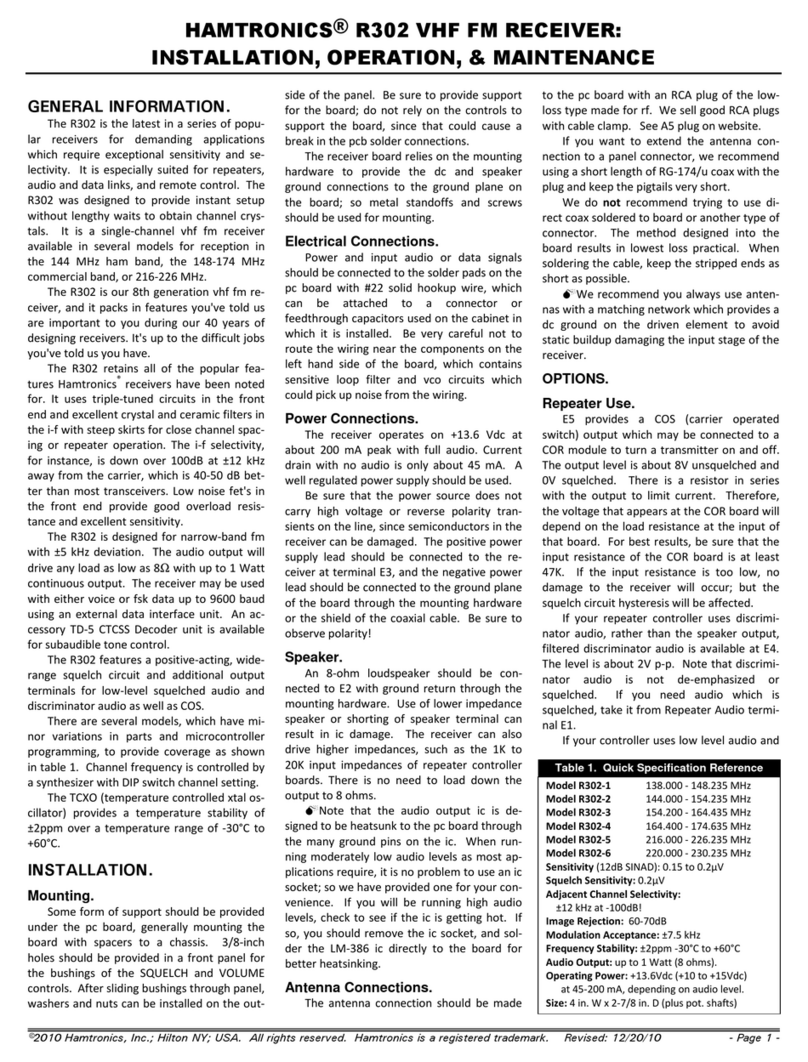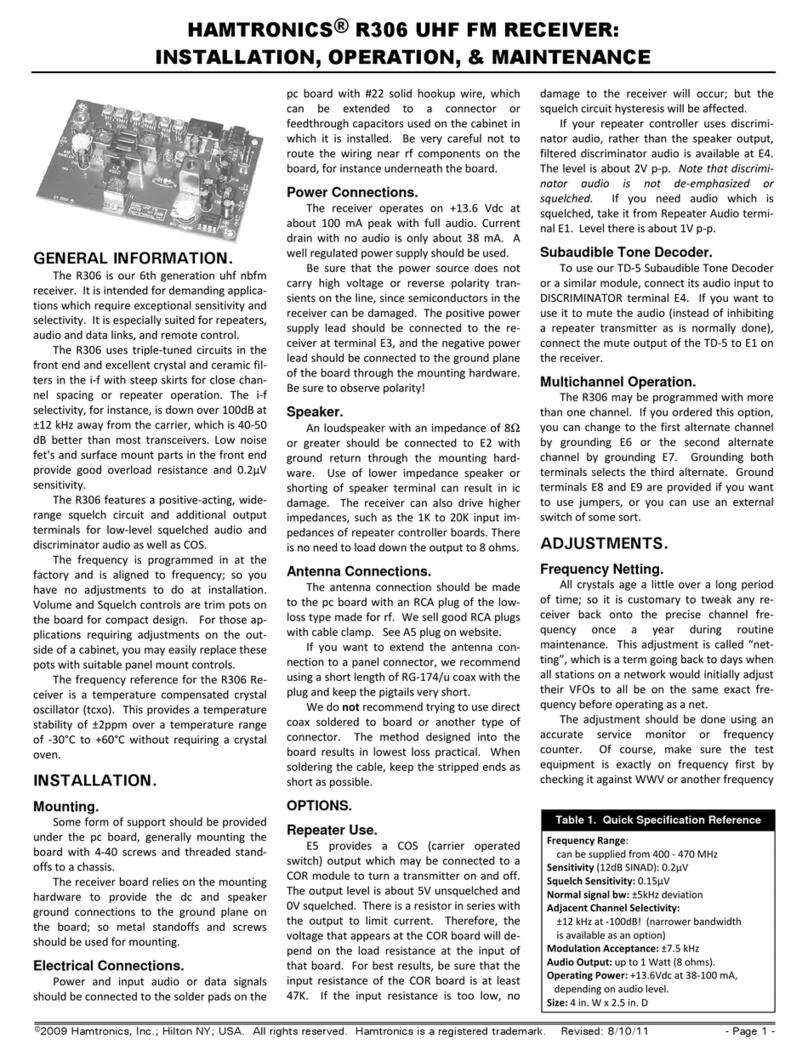
©2012 Hamtronics, Inc.; Rochester NY; USA. All rights reserved. Hamtronics is a registered trademark. Revised: 2/14/16 - Page 3 -
to turn a squelch transistor on and off inside
the ic, which grounds the audio path when on-
ly noise is present. Inverter Q6 provides a dc
output for use as a COS signal to repeater
controllers.
The injection frequency for the first mixer
is generated by vco (voltage controlled oscilla-
tor) Q1. The injection frequency is 10.700
MHz below the receive channel frequency.
The output of the vco is buffered by Q2 to
minimize effects of loading and voltage varia-
tions of following stages from modulating the
carrier frequency. The buffer output is ap-
plied through a double tuned circuit to gate 2
of mixer Q5.
The frequency of the vco stage is con-
trolled by phase locked loop synthesizer U2. A
sample of the vco output is applied through
the buffer stage and R1 to a prescaler in U2.
The prescaler and other dividers in the syn-
thesizer divide the sample down to 5kHz. A
reference frequency of 10.240 MHz is gener-
ated by a TCXO (temperature compensated
crystal oscillator). The reference is divided
down to 5 kHz. The two 5kHz signals are
compared to determine what error exists be-
tween them. The result is a varying dc tuning
voltage used to phase lock the vco precisely
onto the desired channel frequency.
The tuning voltage is applied to varactor
diode D1, which varies its capacitance to tune
the tank circuit formed by L1/C15/C16. C12
limits the tuning range of D1. The tuning volt-
age is applied to D1 through a third order low
pass loop filter, which removes the 5kHz ref-
erence frequency from the tuning voltage to
avoid whine. In order for the synthesizer to
lock, the vco must be tuned to allow it to gen-
erate the proper frequency within the range
of voltages the phase detector in the synthe-
sizer can generate, roughly 0.5Vdc to 4.5Vdc.
Serial data to indicate the desired channel
frequency and other operational characteris-
tics of the synthesizer are applied to synthe-
sizer U2 by microcontroller U1. Everything
the synthesizer needs to know about the
band, division schemes, reference frequency,
and oscillator options is generated by the con-
troller. Information about the base frequency
of the band the receiver is to operate on and
the channel within that band is calculated in
the controller based on information pro-
grammed in the eprom on the controller.
Whenever the microcontroller boots at power
up, the microcontroller sends several bytes of
serial data to the synthesizer, using the data,
clock, and /enable lines running between the
two ic’s. Terminals E6 & E7 allow alternate
frequencies to be selected for those receivers
programmed to use that feature.
+13.6Vdc power for the Receiver is ap-
plied at E3. Audio output amplifier U5 is
powered directly by the +13.6Vdc. All the
other stages are powered through 5V regula-
tor U6 for stability and to eliminate noise.
Additional filtering for the vco and buffer
stages is provided by capacitance amplifier
Q3, which uses the characteristics of an emit-
ter follower to provide a very stiff supply,
eliminating any possible noise on the power
supply line.
TROUBLESHOOTING.
General.
The usual troubleshooting techniques of
checking dc voltages and signal tracing with
an RF voltmeter probe and oscilloscope will
work well in troubleshooting the R303. DC
voltage charts and a list of typical audio levels
are given to act as a guide to troubleshooting.
Although voltages may vary widely from set to
set and under various operating and measure-
ment conditions, the indications may be help-
ful when used in a logical troubleshooting
procedure.
Current Drain.
Power line current drain normally is about
38 mA with volume turned down or squelched
and up to 100 mA with full audio output.
If the current drain is approximately 100
mA with no audio output, check to see if volt-
age regulator U6 is hot. If so, and the voltage
on the 5V line is low, there is a short circuit on
that bus somewhere and U6 is limiting the
short circuit current to 100mA to protect the
receiver from damage. If you clear the short
circuit, the voltage should rise again. U6
should not be damaged by short circuits on its
output line; however, it may be damaged by
reverse voltage or high transient voltages.
Audio Output Stage.
Note that audio output ic U5 is designed
to be heatsunk to the pc board through the
many ground pins on the ic.
If audio is present at the volume control
but not at the speaker, the audio ic may have
been damaged by reverse polarity or a tran-
sient on the B+ line. This is fairly common
with lightning damage.
If no audio is present on the volume con-
trol, the squelch circuit may not be operating
properly. Check the dc voltages, and look for
noise in the 10 kHz region, which should be
present at U1-pin 11 with no input signal.
(Between pins 10 and 11 of U1 is an op-amp
active filter tuned to 10 kHz.)
RF Signal Tracing.
If the receiver is completely dead, try a
10.700 MHz signal applied to TP-3 using coax
test lead. Set level just high enough for full
quieting. At 1 µV, you should notice some
quieting, but you need something near full
quieting for the test.
You can also connect the 10.700 MHz test
lead through a blocking capacitor to various
sections of the crystal filter to see if there is a
large loss of signal across one of the filter sec-
tions. Also, check the 10.245 MHz oscillator
with a scope or by listening with an hf receiver
or service monitor.
A signal generator on the channel fre-
quency can be injected at various points in the
front end. If the mixer is more sensitive than
the RF amplifier, the RF stage is suspect.
Check the dc voltages looking for a damaged
fet, which can occur due to transients or re-
verse polarity on the dc power line. Also, it is
possible to have the input gate (gate 1) of the
RF amplifier fet damaged by high static charg-
es or high levels of RF on the antenna line,
with no apparent change in dc voltages, since
the input gate is normally at dc ground.
Synthesizer Circuits.
Following is a checklist of things to look
for if the synthesizer is suspected of not per-
forming properly.
a. Check the output frequency of the
vco buffer with a frequency counter.
c. Check tuning voltage at TP1. It
should be about +2.0Vdc. Actual range over
which the unit will operate is about +0.5Vdc
to about +4.5Vdc. However, for optimum re-
sults, the vco should be tuned to allow opera-
tion at about +2.0Vdc center voltage.
d. Check the operating voltage and bias
on the vco and buffer.
e. Check the TCXO at pin 1 of the syn-
thesizer ic. A scope should show strong signal
(1.5 Vp-p) at 10.240 MHz.
f. The data, clock, and latch enable lines
between the microcontroller and synthesizer
ic’s should show very brief and very fast activ-
ity, sending data to the synthesizer ic shortly
after the power is first applied or a dip switch
setting is changed. Because this happens very
fast, it can be difficult to see on a scope. Use
1mSec/div, 5Vdc/div, and normal trigger.
Microphonics, Hum, and Noise.
The vco and loop filter are very sensitive
to hum and noise pickup from magnetic and
electrical sources. Some designs use a shield-
ed compartment for vco’s. We assume the
whole board will be installed in a shielded en-
closure; so we elected to keep the size small
by not using a separate shield on the vco.
However, this means that you must use care
to keep wiring away from the vco circuit at
the right side of the board. Having the board
in a metal enclosure will shield these sensitive
circuits from florescent lights and other strong
sources of noise.
Because the frequency of a synthesizer
basically results from a free running L-C oscil-
lator, the tank circuit, especially L1, is very
sensitive to microphonics from mechanical
noise coupled to the coil. You should mini-
mize any sources of vibration which might be
coupled to the receiver, such as motors. In
addition, it helps greatly to prevent the mold-
ed coil from vibrating with respect to the
shield can. Both the coil and can are soldered
to the board at the bottom, but the top of the
